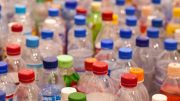These researchers plan to use Perth poo to find out exactly how much plastic we eat and what we can do about it.
How would you feel knowing you probably eat at least 74,000 pieces of plastic a year?
It’s a pretty alarming figure, but that’s the shocking findings of some recent Canadian research making global headlines, with estimates the average person consumes between 74,000 and 120,000 microplastic particles every year.
But are microplastics actually bad for us? And is it even possible to reduce the number of microplastic particles we eat?
Microplastics 101
Microplastics are tiny plastic particles smaller than 5mm.
Some come from the breakdown of larger plastics. Others – like microbeads in exfoliating shower gels – are manufactured that way.
They end up in our water and even floating in the air.
“There’s so many kinds of microplastics, and they’re essentially everywhere,” says UWA Professor of Environmental Engineering Anas Ghadouani.
Anas says every time you open a milk bottle, for instance, you risk a tiny piece of plastic breaking off and falling into the milk.
Another source is microfibres, which shed from our clothes.
“Every time we do a load of washing … there are at least 40,000 to 50,000 particles that are actually released,” Anas says.
These particles then drain into our rivers and oceans, where they are consumed by the seafood we eat.
Harmful to human health?
Anas says we don’t really understand the effects microplastics have on our bodies.
He’s concerned about toxins or pathogens hitching a ride on the tiny particles and the effects microplastics could have on the bloodstream or human brain.
In the Canadian research, one of the biggest culprits was bottled water.
The study found people who only drink bottled water could consume 90,000 microplastics a year more than those who only drink tap water.
But the research had some big limitations.
For one, the scientists didn’t actually measure how many microplastics people ate.
Instead, they took the number of microplastic particles in fish, shellfish, added sugars, salts, alcohol, water and air.
Then they calculated how many particles a person would eat if they followed American dietary guidelines.
Putting poo to the test
ECU nutrition researcher Dr Angela Genoni has a better idea.
She and Anas want to analyse the microplastics passing through our systems by searching for them in poo.
They plan to start with two days of faecal samples from 90 Perth people, which Angela has sitting in the freezer from her PhD research.
Angela also has diet records from the people who donated their poo.
“If I find plastic and I’m able to work out what type of plastic it is … then we can start to see if there’s any statistical associations with the type of foods people have consumed,” she says.
“Then we can actually go to the food suppliers and test those foods and work out where the contamination’s coming from.”
Angela says the project is a world first.
“It’s good that WA’s going to be leading the way here in terms of establishing the risk in the food supply,” she says.
Cutting down on microplastics
While we’re waiting for the research (and global action on microplastics), Anas says there’s lots we can do to reduce the number of particles we’re exposed to.
It starts with what we eat.
Anas suggests casting a critical eye around your home at containers, utensils and anything else made of plastic that could end up in your food.
He also recommends avoiding products in excess packaging, stealing lemons from neighbours’ trees rather than buying food in plastic and eschewing glitter.
Oh, and only wearing activewear – some of the worst clothing for microplastics as it turns out – if you’re actually exercising.
The world would be a better place all round.
July 18th, 2019
By Michelle Wheeler
This article was originally published on Particle. Read the original article.



